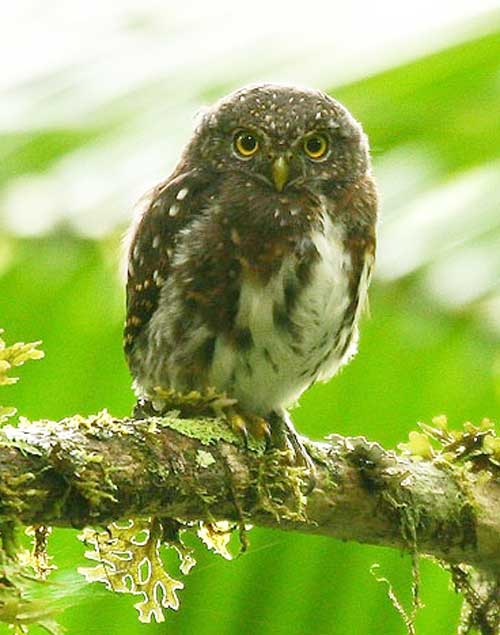
Glaucidium costaricanum (*)
Superregnum: Eukaryota
Cladus: Unikonta
Cladus: Opisthokonta
Cladus: Holozoa
Regnum: Animalia
Subregnum: Eumetazoa
Cladus: Bilateria
Cladus: Nephrozoa
Superphylum: Deuterostomia
Phylum: Chordata
Subphylum: Vertebrata
Infraphylum: Gnathostomata
Megaclassis: Osteichthyes
Cladus: Sarcopterygii
Cladus: Rhipidistia
Cladus: Tetrapodomorpha
Cladus: Eotetrapodiformes
Cladus: Elpistostegalia
Superclassis: Tetrapoda
Cladus: Reptiliomorpha
Cladus: Amniota
Classis: Reptilia
Cladus: Eureptilia
Cladus: Romeriida
Subclassis: Diapsida
Cladus: Sauria
Infraclassis: Archosauromorpha
Cladus: Crurotarsi
Divisio: Archosauria
Cladus: Avemetatarsalia
Cladus: Ornithodira
Subtaxon: Dinosauromorpha
Cladus: Dinosauriformes
Cladus: Dracohors
Cladus: Dinosauria
Ordo: Saurischia
Cladus: Eusaurischia
Subordo: Theropoda
Cladus: Neotheropoda
Cladus: Averostra
Cladus: Tetanurae
Cladus: Avetheropoda
Cladus: Coelurosauria
Cladus: Tyrannoraptora
Cladus: Maniraptoromorpha
Cladus: Maniraptoriformes
Cladus: Maniraptora
Cladus: Pennaraptora
Cladus: Paraves
Cladus: Eumaniraptora
Cladus: Avialae
Infraclassis: Aves
Cladus: Euavialae
Cladus: Avebrevicauda
Cladus: Pygostylia
Cladus: Ornithothoraces
Cladus: Ornithuromorpha
Cladus: Carinatae
Parvclassis: Neornithes
Cohors: Neognathae
Cladus: Neoaves
Ordo: Strigiformes
Familia: Strigidae
Subfamilia: Surniinae
Genus: Glaucidium
Species: Glaucidium costaricanum
Name
Glaucidium costaricanum Kelso, 1937
References
The Auk 54 p. 304
Vernacular names
čeština: Kulíšek kostarický
English: Costa Rican Pygmy Owl
The Costa Rican pygmy owl (Glaucidium costaricanum) is a small "typical owl" in subfamily Surniinae. It is found in Costa Rica and Panama.[3][4]
Taxonomy and systematics
The Costa Rican pygmy owl was originally described as a subspecies of the Andean pygmy owl (G. jardinii). In 2000 the North American Classification Committee (NACC) of what was then the American Ornithologists' Union (now the American Ornithological Society) accepted it as a separate species and other taxonomic systems followed suit. It is more closely related to the northern pygmy owl complex (G. gnoma sensu lato) than to the Andean.[5][3][4][6] The species is monotypic.[3]
Description
The Costa Rican pygmy owl is 14.5 to 17 cm (5.7 to 6.7 in) long. Males weigh 53 to 70 g (1.9 to 2.5 oz) and females as much as 99 g (3.5 oz). Adults have two color morphs, one mostly brown and the other rufous. The head and upperparts are the basal color with paler spots, and the tail is the same color with four white bands and a white tip. The nape has a pair of blackish spots with pale borders that resemble eyes. The breast and belly are white and the flanks are the basal color. The facial disc is the basal color with narrow buff and white marks. Its eyes and feet are yellow, the maxilla greenish yellow, and the mandible light brown with a yellow tip.[7]
Distribution and habitat
The Costa Rican pygmy owl is found in the Cordillera Central and Cordillera de Talamanca of Costa Rica and patchily into far western Panama. It inhabits the canopy and edges of humid montane oak and evergreen forests. In Costa Rica it ranges from about 900 to 3,000 m (3,000 to 9,800 ft) in elevation on the Caribbean slope and about 1,200 to 3,000 m (3,900 to 9,800 ft) on the Pacific slope.[7][8]
Behavior
Movement
The Costa Rican pygmy owl is a year-round resident throughout its range.[7]
Feeding
The Costa Rican pygmy owls forages both day and night. It hunts from a low perch in dense foliage and takes prey in "a short, swift dash". If the target is missed, the bird typically returns to the perch rather than pursuing. Its diet has not been defined in detail but is known to include birds, small mammals and other vertebrates, and large arthropods. Like other pygmy owls, they swish their tails from side to side when agitated.[7]
Breeding
The Costa Rican pygmy owl's breeding phenology is not well known. It nests in tree cavities, perhaps mostly old woodpecker holes. One nest was found in March and contained three eggs.[7]
Dickcissel male perched on a metal pole singing, with neck stretched and beak open.
Songs and calls
Listen to Costa Rican pygmy owl on xeno-canto
Vocalization
The Costa Rican pygmy owl's song is "a long series of clear, unmodulated toots in an irregular rhythm". The toots can be in pairs, in a series of three pairs, or in a continuous series of single notes. When excited, it gives a faster, higher-pitched series of five toots.[7]
Status
The IUCN has assessed the Costa Rican pygmy owl as being of Least Concern. Though its population size is not known it is believed to be stable. No specific threats have been identified.[1] It is considered rare in Panama and rare to locally fairly common in Costa Rica. "Human activity has little short-term direct effect on [the] Costa Rican Pygmy-Owl, other than the local effects of habitat destruction."[7]
References
BirdLife International (2016). "Costa Rican Pygmy-owl Glaucidium costaricanum". IUCN Red List of Threatened Species. 2016: e.T22729005A95003007. doi:10.2305/IUCN.UK.2016-3.RLTS.T22729005A95003007.en. Retrieved 7 March 2022.
"Appendices | CITES". cites.org. Retrieved 2022-01-14.
Gill, F.; Donsker, D.; Rasmussen, P., eds. (January 2022). "Owls". IOC World Bird List. v 12.1. Retrieved January 15, 2022.
HBW and BirdLife International (2020) Handbook of the Birds of the World and BirdLife International digital checklist of the birds of the world Version 5. Available at: http://datazone.birdlife.org/userfiles/file/Species/Taxonomy/HBW-BirdLife_Checklist_v5_Dec20.zip [.xls zipped 1 MB] retrieved 27 May 2021
Richard C. Banks, Carla Cicero, Jon L. Dunn, Andrew W. Kratter, Henri Ouellet, Pamela C. Rasmussen, J. V. Remsen, Jr., James D. Rising, and Douglas F. Stotz. "Forty-second supplement to the American Ornithologists' Union Check-list of North American Birds". The Auk 2000, vol. 117:847-858 retrieved March 7, 2022
Clements, J. F., T. S. Schulenberg, M. J. Iliff, S. M. Billerman, T. A. Fredericks, J. A. Gerbracht, D. Lepage, B. L. Sullivan, and C. L. Wood. 2021. The eBird/Clements checklist of Birds of the World: v2021. Downloaded from https://www.birds.cornell.edu/clementschecklist/download/ Retrieved 25 August 2021
Schulenberg, T. S. (2020). Costa Rican Pygmy-Owl (Glaucidium costaricanum), version 1.0. In Birds of the World (T. S. Schulenberg, Editor). Cornell Lab of Ornithology, Ithaca, NY, USA. https://doi.org/10.2173/bow.crpowl.01 retrieved March 7, 2022
Garrigues, Richard; Dean, Richard (2007). The Birds of Costa Rica: A Field Guide. Ithaca, NY: Comstock Publishing Associates/Cornell University Press. pp. 108–109. ISBN 978-0-8014-7373-9.
Retrieved from "http://en.wikipedia.org/"
All text is available under the terms of the GNU Free Documentation License

